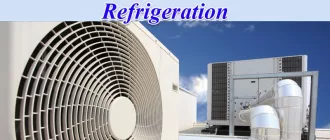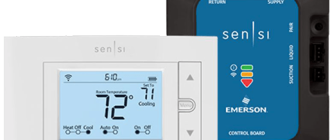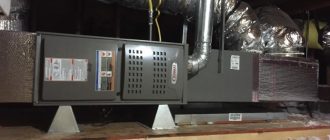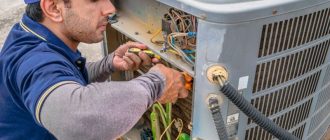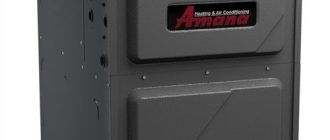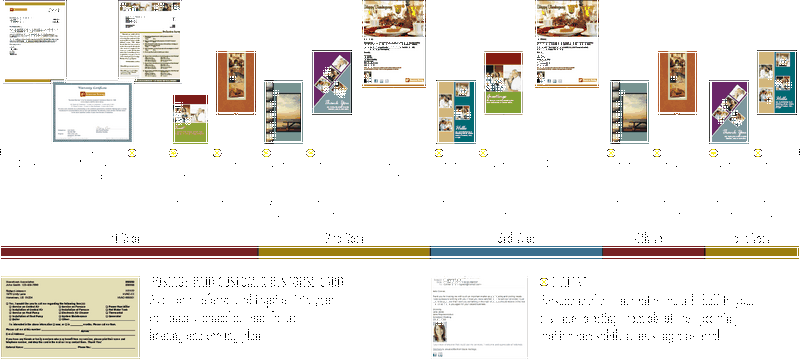
The Evolution of HVAC: Is It on Par with Smartphone Technology?
In the constant par for innovation, smartphone technology has revolutionized the way we interact with the world around us. Now, imagine if the evolution of HVAC could do the same.
HVAC, or Heating, Ventilation, and Air Conditioning, is the backbone of comfort in any building. The evolution of HVAC technology has come a long way, and it’s time to see how it stacks up against smartphone technology.
With the advent of smart thermostats and other HVAC control systems, it is now possible to have complete control over your heating and cooling systems right from your smartphone. No longer do you have to fiddle with manual controls or guess at the perfect temperature. The evolution of HVAC has made it possible to optimize your comfort and energy efficiency with the touch of a button.
Smartphone technology has also brought about the rise of smart sensors and automation. Now, HVAC systems can detect occupancy and adjust settings accordingly, ensuring that you are only heating or cooling the rooms that are in use. This not only saves energy but also improves the overall comfort of the space.
But the evolution of HVAC doesn’t stop there. With advancements in machine learning and artificial intelligence, HVAC systems can now learn your preferences and adjust settings automatically. They can analyze data from various sensors and external factors, such as weather forecasts, to optimize the temperature and airflow of your space, providing you with the perfect environment at all times.
So, the next time you think about the evolution of smartphone technology, don’t forget to consider the strides that HVAC has made as well. It’s no longer just about staying connected; it’s about staying comfortable and in control with the evolution of HVAC.
The Evolution of HVAC
The evolution of HVAC (Heating, Ventilation, and Air Conditioning) technology has been a remarkable journey. From its humble beginnings to the modern-day systems, HVAC has undergone significant advancements and improvements.
In the past, HVAC systems were basic and often inefficient. They relied on simple heating and cooling mechanisms that were not very effective. However, with the advent of new technologies, HVAC systems have become more efficient and sophisticated.
One of the key developments in the evolution of HVAC is the integration of smart technology. HVAC systems can now be controlled and monitored remotely using smartphones and other mobile devices. This allows users to adjust temperature settings, monitor energy usage, and even receive notifications and alerts about system performance.
Another significant advancement in HVAC technology is the use of advanced sensors and automation. These sensors can detect changes in temperature, humidity, and air quality, allowing the system to automatically adjust settings for optimal comfort and energy efficiency. This automation greatly improves the efficiency of HVAC systems, reducing energy consumption and costs.
The evolution of HVAC is also marked by the integration of renewable energy sources. Solar panels and geothermal systems can be used to generate clean energy for heating and cooling, reducing reliance on traditional fossil fuels. This not only benefits the environment but also helps homeowners save on energy bills.
In conclusion, the evolution of HVAC technology has revolutionized the way we heat, cool, and ventilate our homes and buildings. With advancements in smart technology, automation, and renewable energy integration, HVAC systems have become more efficient, cost-effective, and environmentally friendly. It is safe to say that the future of HVAC is bright and filled with even more innovations to come.
The Origins of HVAC
The evolution of HVAC technology has come a long way, but it all started with the simple desire for a comfortable indoor environment. The origins of HVAC can be traced back to ancient civilizations, where early humans sought ways to regulate the temperature inside their dwellings.
In ancient Rome, the concept of “hvac” (heating, ventilation, and air conditioning) can be seen in action with the use of hypocaust systems. These systems involved an intricate network of channels and pipes underneath the floors, where hot air produced by a wood-burning furnace would circulate to heat the space.
Fast forward to the 19th century, and we see the beginnings of modern HVAC technology. The Industrial Revolution brought about advancements in manufacturing and engineering, which led to the development of improved heating and cooling systems.
One of the key figures in the evolution of HVAC is Willis Carrier, who is often regarded as the “father of air conditioning”. In 1902, Carrier invented the first modern air conditioning system, which used a combination of fans, coils, and compressors to cool the air and regulate humidity.
Since then, HVAC technology has continued to evolve and improve. Today, it is a sophisticated and essential part of our everyday lives. It not only provides us with comfort but also plays a crucial role in maintaining healthy indoor air quality.
When comparing HVAC technology with smartphone technology, it is clear that both have had a significant impact on our lives. While smartphones have revolutionized communication and access to information, HVAC technology has transformed our indoor living spaces, making them more comfortable, efficient, and sustainable.
In conclusion, the origins of HVAC can be traced back to ancient civilizations, where the desire for a comfortable indoor environment sparked the development of various heating and cooling systems. As technology advanced, so did HVAC, and today it stands as a vital part of our lives, working in tandem with smartphone technology to enhance our overall quality of life.
Early HVAC Systems
In the early days of HVAC (heating, ventilation, and air conditioning) systems, it was clear that the industry was in its infancy. The technology was far from the efficient and sophisticated systems we have today. But even in its early stages, HVAC showed great promise.
Early HVAC systems were primarily focused on heating, as the demand for cooling was not as high as it is today. The first HVAC systems used rudimentary methods like fireplaces and stoves to provide warmth during cold weather. These systems were often limited to one room or a small area, and were not able to provide a consistent and even distribution of heat throughout a building.
As the technology evolved, so did the HVAC systems. Early attempts at improving efficiency involved the use of steam and hot water systems. These systems used boilers to generate heat, which would then be distributed through pipes to radiators or convectors. While these systems were an improvement over the previous methods, they still had their limitations.
One of the major challenges with early HVAC systems was controlling temperature. The systems were often either on or off, with no ability to regulate the temperature based on the needs of the occupants. This meant that the temperature in a building would fluctuate greatly, leading to discomfort and wasted energy.
In comparison with the evolution of smartphone technology, early HVAC systems may seem primitive. However, it is important to remember that HVAC technology has come a long way. Today, HVAC systems are equipped with advanced sensors, remote control capabilities, and sophisticated algorithms that can optimize energy use and provide personalized comfort. The evolution of HVAC has been driven by the need for energy efficiency, comfort, and convenience, just like the evolution of smartphones.
Modern HVAC Technology
With the evolution of HVAC technology, it is now at par with smartphone technology in terms of innovation and convenience. The advancements in HVAC systems have revolutionized the way we cool and heat our homes and buildings.
HVAC systems now come equipped with smart features that allow users to control and monitor their indoor climate through their smartphones. With the power of connectivity, homeowners can adjust the temperature, fan speed, and humidity levels in their homes with just a tap on their smartphone screens.
Smart thermostats have become a popular addition to HVAC systems, allowing users to schedule temperature changes throughout the day to optimize energy usage and save on utility bills. These intuitive devices learn from the user’s behavior and adjust the settings accordingly, creating a comfortable and energy-efficient environment.
In addition to smartphone integration, modern HVAC systems are also designed with advanced sensors and algorithms that optimize energy consumption. These systems can detect occupancy and adjust the heating and cooling accordingly, ensuring that energy is not wasted on empty rooms.
Moreover, the evolution of HVAC technology has led to the development of quieter and more efficient systems. With improved insulation and soundproofing, homeowners can enjoy a comfortable indoor environment without the distraction of noisy HVAC units.
The integration of HVAC technology with smartphone technology has truly transformed the way we control and experience our indoor climate. Homeowners now have the power to create personalized comfort, conserve energy, and reduce costs, all at the touch of a button.
It is clear that modern HVAC technology is constantly evolving to meet the needs of efficiency, convenience, and comfort. With the advancements in smart features, connectivity, and energy optimization, HVAC systems have become an essential component of a modern, technologically advanced home.
Benefits of HVAC
When it comes to the benefits of HVAC, it is clear that the evolution of this technology has greatly improved our lives. HVAC, which stands for Heating, Ventilation, and Air Conditioning, plays a crucial role in maintaining a comfortable indoor environment.
One of the main advantages of HVAC is its ability to regulate the temperature in a space. With the evolution of HVAC technology, it has become more efficient and reliable in providing optimal heating and cooling. Whether it’s the scorching heat of summer or the frigid winter cold, HVAC ensures that we can enjoy a comfortable living environment all year round.
Another benefit of HVAC is its impact on our health. By providing proper ventilation, it helps to circulate fresh air and remove stale air, odors, and pollutants from our indoor spaces. This is especially important for people with respiratory conditions or allergies, as HVAC helps to filter out harmful particles that can trigger these conditions.
HVAC also plays a role in improving energy efficiency and reducing costs. The evolution of HVAC technology has led to the development of more energy-efficient systems, with features like programmable thermostats and zone control. This allows us to better manage the temperature in different areas of our homes or buildings, which can lead to significant energy savings.
Furthermore, HVAC systems can also help to control humidity levels, which is essential for maintaining a healthy indoor environment. High humidity can promote the growth of mold and mildew, while low humidity can cause dryness and discomfort. By properly regulating humidity, HVAC systems contribute to our overall well-being.
In conclusion, the evolution of HVAC technology has revolutionized the way we live and interact with our indoor spaces. From providing optimal temperature control to improving air quality and energy efficiency, HVAC is an essential component of modern living. With continued advancements in technology, we can expect HVAC systems to become even more efficient, intelligent, and integrated with other smart devices.
HVAC vs Traditional Cooling Systems
Traditional cooling systems, such as fans or window units, have been in use for decades. While they are simple and affordable options, their cooling power is limited. These systems rely on the circulation of air to provide cooling, which can be inefficient and ineffective in larger spaces.
HVAC technology, on the other hand, has evolved significantly over the years. HVAC stands for Heating, Ventilation, and Air Conditioning, and it utilizes advanced technology to provide efficient and effective cooling. HVAC systems are designed to regulate and control the temperature, humidity, and air quality of a space.
One of the key advantages of HVAC systems is their ability to adapt to changing conditions. Traditional cooling systems can only provide cooling, whereas HVAC systems can both heat and cool a space. This versatility makes HVAC systems a great choice for year-round comfort.
Another advantage of HVAC technology is its integration with smart home systems. With the advent of smartphone technology, HVAC systems can now be controlled remotely through mobile apps. This means that you can adjust the temperature of your space from anywhere, ensuring that it is comfortable when you arrive.
In terms of efficiency, HVAC systems are also a cut above traditional cooling systems. HVAC systems are built with energy-efficient components and advanced controls, resulting in lower energy consumption and reduced utility bills. This not only benefits your wallet but also the environment.
In conclusion, HVAC technology has surpassed traditional cooling systems in terms of evolution and capabilities. It is now par with smartphone technology, offering advanced features and controls. If you are looking for a cooling system that is efficient, adaptable, and technologically advanced, HVAC is the way to go.
HVAC and Energy Efficiency
When comparing HVAC systems to smartphone technology, it is clear that HVAC technology has come a long way. One area where HVAC systems are truly outshining smartphones is energy efficiency.
Smartphones are known for their advanced technology and capabilities, but when it comes to conserving energy, HVAC systems are in a league of their own. HVAC systems are designed to regulate and control the temperature of a space efficiently, reducing the amount of energy needed to maintain a comfortable environment.
Unlike smartphones, HVAC systems are specifically engineered to optimize energy usage and reduce waste. They are equipped with sensors and smart controls that allow them to adjust temperature settings based on occupancy, time of day, and external conditions. This ensures that energy is not wasted on heating or cooling an empty space or maintaining unnecessarily high or low temperatures.
In addition, HVAC systems often come with energy-saving features such as programmable thermostats, zoning capabilities, and variable speed technology. These features enable HVAC systems to deliver the right amount of conditioned air to each area of a building, minimizing energy usage and maximizing comfort.
Furthermore, HVAC systems are designed to work in tandem with other energy-efficient technologies, such as smart lighting and building automation systems. This integration allows for better coordination and synchronization of energy usage, further reducing energy waste and improving overall energy efficiency.
In summary, while smartphone technology continues to evolve and impress, HVAC technology remains at the forefront when it comes to energy efficiency. HVAC systems are purpose-built to optimize energy usage and reduce waste, making them an essential component in creating sustainable and environmentally friendly spaces.
HVAC and Indoor Air Quality
In the evolution of HVAC, it is important to consider its impact on indoor air quality. With the advancements in technology, HVAC systems have become more efficient and effective in providing clean and healthy air for indoor environments.
One of the key advantages of HVAC technology is its ability to filter and remove various contaminants from the air, such as dust, pollen, and pet dander. This is especially beneficial for individuals with allergies or respiratory conditions, as it helps to create a healthier living environment.
Additionally, HVAC systems can also help regulate humidity levels, preventing the growth of mold and mildew. This is crucial for maintaining good indoor air quality, as mold spores and other allergens can have a negative impact on the health of occupants.
Furthermore, HVAC technology has made significant advancements in terms of energy efficiency. By optimizing the heating and cooling process, HVAC systems can provide comfort while also reducing energy consumption. This is not only cost-effective but also contributes to a more sustainable and environmentally friendly indoor environment.
Overall, the evolution of HVAC technology has greatly improved indoor air quality. With its ability to filter contaminants, regulate humidity levels, and enhance energy efficiency, HVAC systems play a vital role in creating a healthy and comfortable indoor environment for everyone.
HVAC and Temperature Control
When it comes to temperature control technology, HVAC is on par with smartphone technology. The evolution of HVAC has revolutionized the way we control and maintain the perfect temperature in our homes and workplaces.
HVAC, or Heating, Ventilation, and Air Conditioning, is a technology that is designed to provide comfortable indoor temperatures and optimal air quality. With the advancements in technology, HVAC systems have become more efficient, intelligent, and user-friendly.
Similar to how smartphones have evolved to become essential gadgets in our lives, HVAC systems have also evolved to be an integral part of our modern lifestyle. Nowadays, HVAC systems can be controlled remotely through smartphone apps, allowing users to conveniently adjust the temperature and monitor energy usage from anywhere.
With the evolution of HVAC technology, temperature control has become more precise and customizable. Smart thermostats with advanced features, such as learning algorithms, can analyze and adapt to the users’ preferences and schedule. This not only provides optimal comfort but also helps in reducing energy consumption.
In addition, HVAC systems now come with sensors and sensors that can detect humidity, air quality, and occupancy. These features allow for more efficient operation by adjusting the system’s performance based on the environment and occupancy level. Overall, the technological advancements in HVAC have made temperature control more comfortable, intuitive, and energy-efficient.
In conclusion, HVAC technology has come a long way in its evolution, and it is now on par with smartphone technology. The ability to control and monitor HVAC systems from anywhere using smartphone apps has revolutionized the way we manage our indoor climate. With its precise temperature control, intelligent features, and energy-efficient performance, HVAC has become an essential component of modern living.
HVAC and Noise Pollution
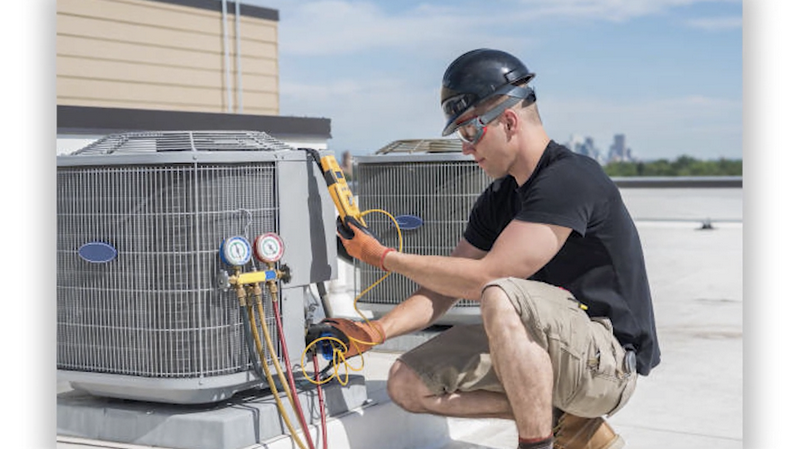
With the evolution of smartphone technology, it is no surprise that HVAC systems have also made significant advancements. However, like all technological innovations, HVAC systems come with their own set of challenges. One such challenge is noise pollution.
The sound produced by HVAC systems can be a nuisance in both residential and commercial settings. In fact, noise pollution from HVAC systems can have adverse effects on human health and well-being. Studies have shown that prolonged exposure to excessive noise levels can lead to stress, sleep disturbances, and even cardiovascular problems.
The good news is that HVAC technology is constantly improving to address this issue. Manufacturers are now designing HVAC systems with quieter operation in mind. Thanks to advancements in fan and motor technology, newer HVAC systems are significantly quieter than their predecessors.
In addition to technological advancements, proper installation and maintenance of HVAC systems also play a crucial role in reducing noise pollution. By ensuring that HVAC units are properly sized and installed, and by regularly cleaning and maintaining them, the noise levels can be kept to a minimum.
Furthermore, there are additional measures that can be taken to mitigate noise pollution from HVAC systems. For example, acoustic enclosures and sound barriers can be installed around the HVAC units to reduce the transmission of noise to the surrounding areas. Additionally, ductwork can be insulated to further dampen the noise.
In conclusion, while HVAC systems have come a long way in terms of technology, noise pollution remains a challenge. However, with the continuous evolution of HVAC technology and proper installation and maintenance practices, we can ensure that HVAC systems operate more quietly, providing comfortable environments without compromising our health and well-being.
HVAC and Smart Homes
As technology continues to evolve, HVAC systems are keeping pace with the advancements in smartphone technology. Today, smart homes are becoming more popular, and HVAC systems are an integral part of these connected homes.
With the evolution of HVAC technology, homeowners now have the ability to control their heating, ventilation, and air conditioning systems with a smartphone. This allows for greater convenience and control over indoor comfort.
Smart thermostats have emerged as one of the innovative features of HVAC systems in smart homes. These thermostats can be controlled remotely through a smartphone app, allowing homeowners to easily adjust the temperature based on their preferences and scheduling needs.
Additionally, smart HVAC systems can also utilize sensors and data analysis to optimize energy efficiency. These systems can learn from user behavior and automatically adjust the temperature settings to conserve energy when no one is home or to ensure optimal comfort when occupants are present.
The integration of HVAC systems with smartphone technology has also opened up new possibilities for home automation. Homeowners can now program their HVAC systems to work in tandem with other smart devices, such as security systems and lighting, creating a more seamless and efficient living environment.
In conclusion, HVAC systems have come a long way in their evolution. With smart technology, such as smartphones, HVAC systems are able to provide homeowners with greater control, convenience, and energy efficiency. As smart homes continue to gain popularity, the integration of HVAC systems with smartphone technology is set to revolutionize the way we experience indoor comfort.
How HVAC Works
The evolution of HVAC technology has been an amazing one. It has improved exponentially over the years and is now on par with smartphone technology. But how exactly does HVAC work?
HVAC, which stands for Heating, Ventilation, and Air Conditioning, is a system designed to provide comfortable and healthy indoor environments. It works by controlling the temperature, humidity, and air quality of a space.
The technology behind HVAC is quite sophisticated. It involves a number of components working together to achieve the desired indoor climate. Here is a brief overview of how HVAC works:
- Heating: The heating component of HVAC is responsible for keeping the indoor space warm during colder months. It typically uses a furnace or a heat pump to generate heat and distribute it through the building.
- Ventilation: Ventilation is the process of bringing fresh air into the building and removing stale air. It ensures that the air inside the building is clean and healthy to breathe. HVAC systems usually include fans and air vents to facilitate proper ventilation.
- Air Conditioning: The air conditioning component of HVAC is used to cool down the indoor space during hot summer months. It utilizes a refrigeration cycle to remove heat from the air and distribute the cooled air throughout the building.
- Thermostat Control: The thermostat is the control center of the HVAC system. It allows the user to set and maintain the desired temperature and control other parameters such as humidity and fan speed.
- Ductwork: HVAC systems rely on a network of ducts to distribute conditioned air throughout the building. The ductwork ensures that the air reaches all areas of the building and maintains a consistent indoor climate.
With the advent of smart HVAC technology, it is now possible to control and monitor HVAC systems remotely using a smartphone or other smart devices. This allows for greater convenience and energy efficiency.
In conclusion, HVAC technology has come a long way and is now on par with smartphone technology. Understanding how HVAC works is important for proper maintenance and efficient operation of these systems.
The Role of Smartphone Technology
Smartphone technology has revolutionized many aspects of our daily lives, and its impact on the HVAC industry is no exception. With the evolution of HVAC systems, integrating smartphone technology has become increasingly important for both homeowners and professionals in the industry.
The use of smartphones in HVAC systems allows for more control and convenience. Through dedicated mobile applications and smart thermostats, users can now easily adjust and monitor their HVAC settings from anywhere, at any time. This level of convenience and flexibility is unparalleled, allowing homeowners to optimize energy usage and create a comfortable environment without the need to be physically present.
The integration of smartphone technology with HVAC systems has also led to improved energy efficiency. With real-time monitoring and data collection, homeowners and professionals can identify patterns and adjust settings accordingly to maximize efficiency and reduce energy consumption. This not only saves money on energy bills but also contributes to a greener and more sustainable future.
Furthermore, smartphone technology is paving the way for more advanced features and functionalities in HVAC systems. With the ability to connect with other smart devices in the home, such as smart lighting and security systems, HVAC systems can now work in harmony with other technologies to create a truly connected and convenient living space.
In conclusion, the role of smartphone technology in the HVAC industry is vital in the evolution of these systems. The convenience, control, and energy efficiency it provides are on par with the overall evolution of HVAC technology. As smartphone technology continues to advance, we can expect even more innovative solutions that further enhance the performance and capabilities of HVAC systems.
| Convenience | Allows users to adjust and monitor HVAC settings remotely. |
| Energy Efficiency | Real-time monitoring and data collection help optimize energy usage. |
| Integration | Can connect with other smart devices in the home for a connected living experience. |
| Innovation | Paves the way for more advanced features and functionalities in HVAC systems. |
The Future of HVAC
The evolution of HVAC has been a fascinating journey, intertwining the world of technology with the ever-growing demand for better heating and cooling solutions. As we look to the future, it’s clear that HVAC systems will continue to advance and adapt, keeping pace with the rapid innovation happening in the smartphone industry.
With each passing year, new technology advancements are being made in the HVAC industry. From smart thermostats to energy-efficient systems, HVAC manufacturers are constantly finding ways to improve performance, increase efficiency, and reduce environmental impact.
One of the key areas where the evolution of HVAC is closely aligned with smartphone technology is in seamless connectivity. Just like your smartphone connects you with the digital world, the future of HVAC is all about connectivity and integration. HVAC systems will be able to integrate with other smart devices in your home, allowing for centralized control and automation.
Imagine a future where your HVAC system can communicate with your smartphone, adjusting the temperature and humidity levels based on your preferences and daily routines. With advanced sensors and AI technology, your HVAC system will be able to anticipate your needs and create a personalized climate experience.
Furthermore, the future of HVAC is focused on energy efficiency and sustainability. As climate change becomes an increasing concern, HVAC systems are being redesigned to reduce energy consumption and utilize renewable energy sources. This not only benefits the environment but also helps homeowners save on their energy bills.
In conclusion, the future of HVAC is an exciting one, as it continues to evolve in par with smartphone technology. With seamless connectivity, increased energy efficiency, and a focus on sustainability, HVAC systems are becoming smarter and more user-friendly, ensuring optimal comfort and wellbeing for all.
Q&A:
What is HVAC?
HVAC stands for Heating, Ventilation, and Air Conditioning. It is a system that is used for controlling the temperature, humidity, and air quality in buildings and vehicles.
How does HVAC technology compare to smartphone technology?
HVAC technology and smartphone technology are quite different. HVAC technology focuses on creating comfortable and healthy indoor environments, while smartphone technology is primarily designed for communication and entertainment purposes.
What are the benefits of HVAC technology?
HVAC technology offers a range of benefits, including improved energy efficiency, better indoor air quality, and increased comfort. It allows you to control the temperature and humidity levels in your home or office, creating a more comfortable living or working environment.
Can HVAC systems be controlled through smartphones?
Yes, many modern HVAC systems can be controlled through smartphones. This means that you can adjust the temperature, humidity, and other settings using an app on your phone, providing convenience and flexibility.
How has HVAC technology evolved over the years?
HVAC technology has significantly evolved over the years. In the past, HVAC systems were simple and inefficient, but advancements in technology have led to more energy-efficient and environmentally friendly systems. Additionally, the integration of smart technology has made it easier than ever to control and monitor HVAC systems.
Are HVAC systems becoming more technologically advanced?
Yes, HVAC systems are constantly evolving and becoming more technologically advanced. New features and capabilities are being introduced to make them more efficient, convenient, and user-friendly.
How does HVAC technology compare to smartphone technology?
HVAC technology has made significant advancements, but it still lags behind smartphone technology in terms of innovation and user experience. Smartphones offer more features and are more intuitive to use compared to HVAC systems.

